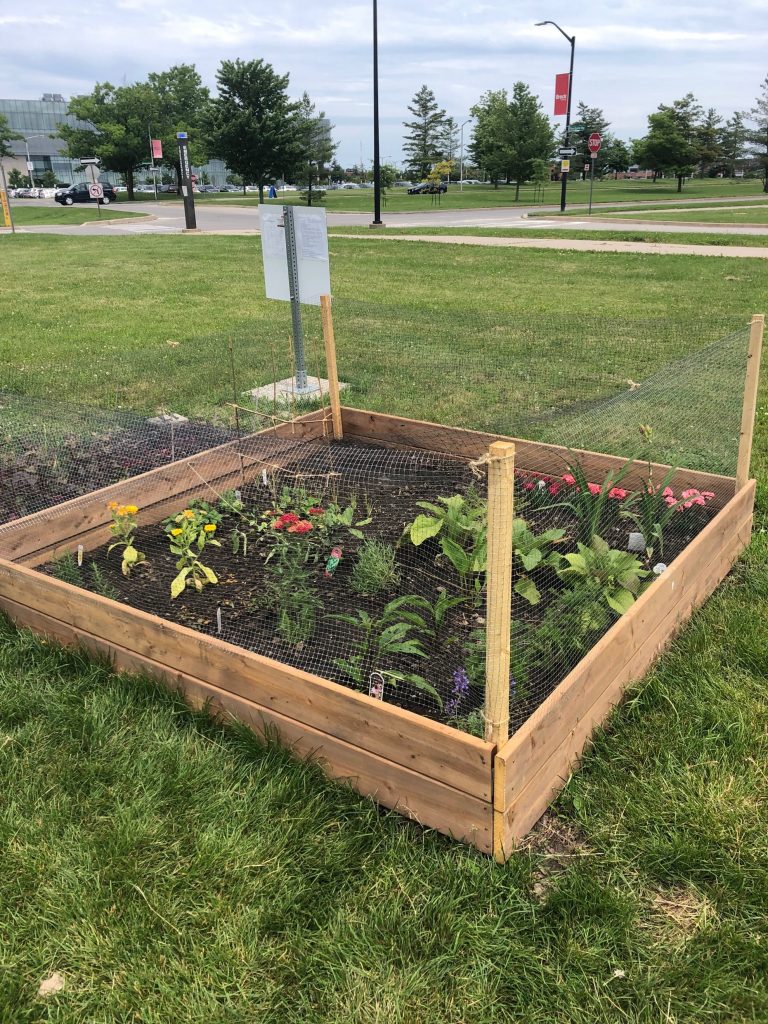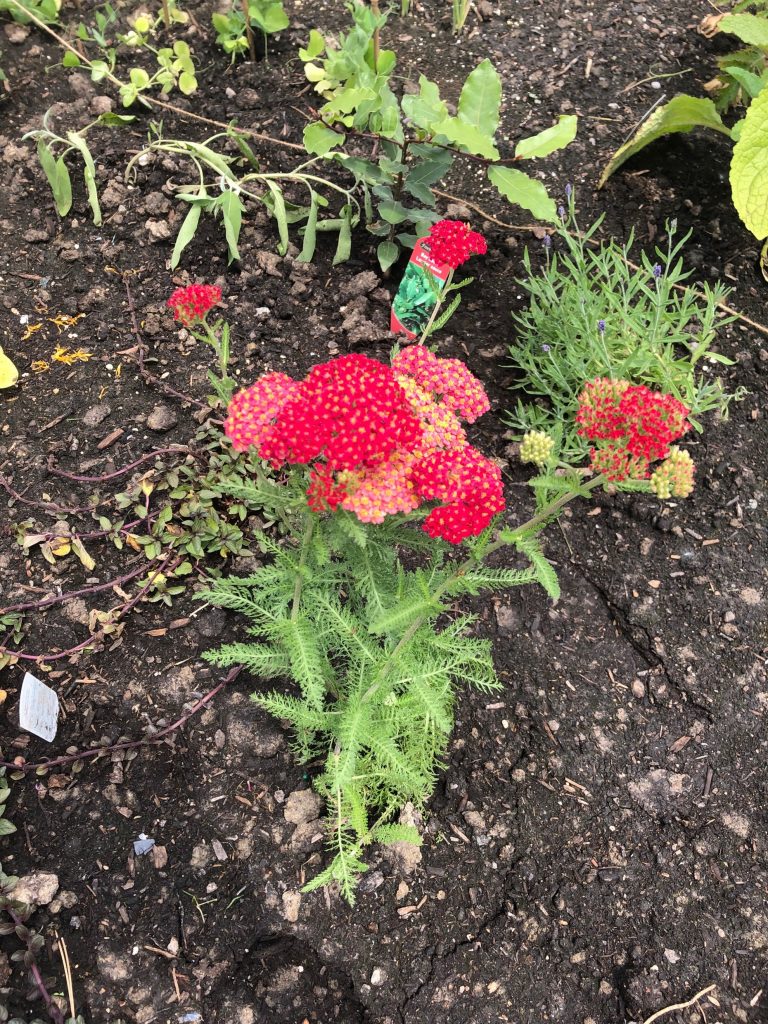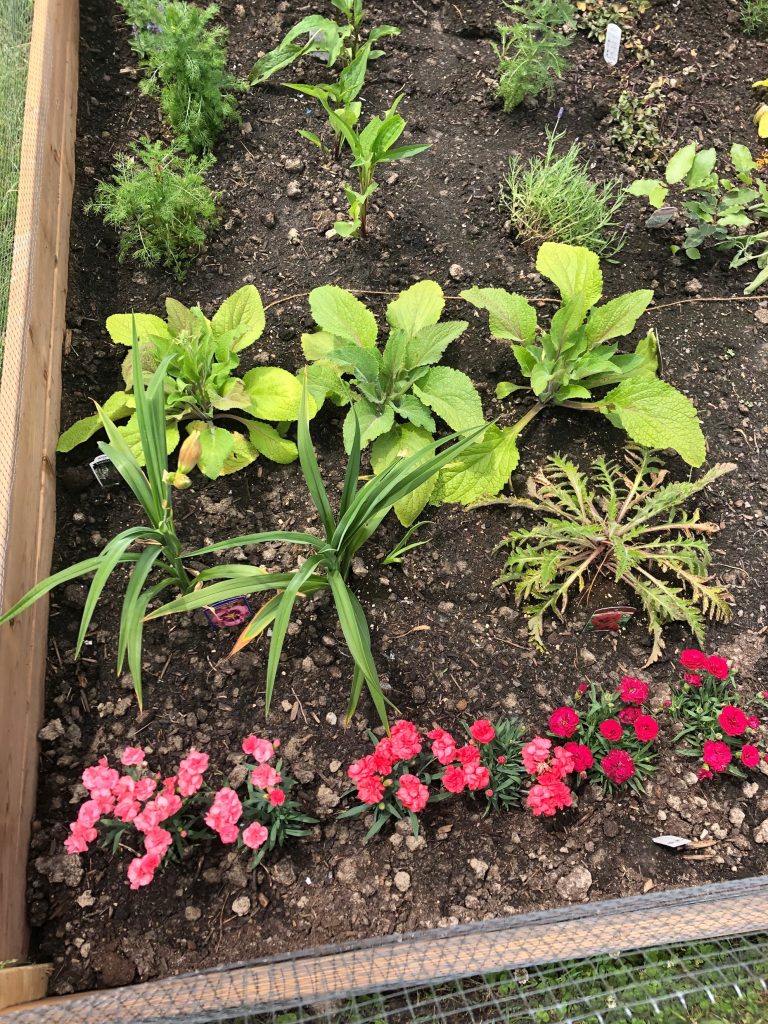By Kaylin Currie
HIST4P50 #BrockHistoricalGardens
For my garden research project, I have decided to grow a medieval monastic garden. It is based on the ones that Christian monks would grow during the medieval period in Europe. Since the monks would have to be self-sustaining, they would have grown a variety of plant species all with their own purpose. Over the course of this project I would like to understand the process and methods used to grow the many plants without the advances of modern science, as well as understanding the religious meaning of gardens and the plants that the monks grew. Many of my sources showed that the plants the monks would grow had a significant meaning or use for the monastery, such as religious symbolism or medicinal purposesI am also interested in comparing how the medicinal herbs were used during the time period to how they are used now.

Kaylin Currie’s medieval garden.
Throughout my childhood my parents kept gardens and house plants. My dad grew many different types of vegetables, including corn, pumpkin, squash, tomatoes, peas and potatoes, and my mom always grew a variety of flowers. We all pitched in as a family to maintain the gardens by weeding and watering together and were rewarded by nice flowers and fresh vegetables all summer and into the fall. My favourite memory was when my sister and I convicted our parents to grow pumpkins. Even though they took over half the yard with vines, we had our own pumpkins in time for Halloween which was a very fun experience. More recently I have been experimenting with growing citrus trees in my student house. It has been a very exciting experience and as of right now I have four lemon seedlings and two clementine seedlings which are all about four inches tall! I’m looking forward to seeing how they will turn out.
When I saw the poster for this project in the Brock History department I was instantly interested. Having the opportunity to grow a garden of my own while learning about history in a practical way was something I could not pass up. I look forward to seeing how my plants grow over the summer and the experience of the community garden at Brock.
I began my research by reading Garden History by Gordon Campbell.[1] There was a small section on medieval gardens, and it helped to guide my research going forward. It offered hints about some types of plants that were grown and the spiritual meaning that the gardens held for the Christian monks who grew them. The book also offered some secondary sources \which helped me find more information and especially primary sources on the subject. One of the sources I was especially excited about was the Bulwarke of Defence Against all Sicknes by William Bulleins.[2] This source outlines many plant species that were used as medicines and that were thought to promote good health. This helped me select the plants I wanted to grow and showcased the way medieval people understood health and the body.
One of the first challenges I faced was while researching my garden. Due to the time period I chose, the sources available were few and far between. There were some secondary sources discussing archeological digs and some sources describing recreations of the medieval gardens, however finding primary sources about the plant species that were grown and their purpose was sometimes difficult. In the end I was able to find reliable sources for my garden and am satisfied that the plants I have chosen are accurate to the time period. Another challenge I faced was while finding the plants for my garden. After I had selected the types of plants I wanted to grow, I went to multiple nurseries in search of them. I found many of the plants right away, such as the lilies, peppermint and catmint. It took a lot of driving around to find all the plants I needed and thanks to some very helpful people at Niagara Nurseries I was able to find almost all of my plants. I was unable to find the Agrimony and Feverfew, which is unfortunate because I was very excited to grow them, but I replaced those two plants with yarrow (Image 2) and lemon balm and did a little rearranging to make them all fit in the garden. I am still waiting for the wheat and rye seeds to arrive in the mail as I was unable to find them anywhere in the area.

Yarrow.
Overall it took me about two and a half days to plant the garden. I spent the first day collecting my resources and building the raised bed. Even though it was hard work and I do not consider myself to be very handy, I am very pleased I was able to put together the raised bed by myself, while also managing to make it look nice too! The following day I got garden soil and compost from the store to put in the garden and mix it with the natural soil from the area. After the soil was thoroughly mixed, I planted all my flowers, herbs, and vegetables in their appropriate areas, which took me until about 10:30pm!
This experience of planting a historical garden has taught me that medieval monastic gardens took a lot of time and constant effort to build and maintain. Building my own raised garden bed was a challenge and a lot of work, even with the modern tools and resources I was able to use. The fact that medieval monks would have been able to plant huge gardens spanning multiple acres which contained a variety of plant species all with their own special care needs is astonishing.

I am very excited about watching my plants grow over the summer. Watching the flowers bloom and fill the garden with colour is something I’m really looking forward to. I planted foxglove and poppies (Image 3) which are two of my favourite flowers in this garden I am also excited to grow and harvest the heirloom carrots as well as the peas and leeks. Finally, the overall experience of growing a historic garden has been a project I have been very excited about and I am enjoying taking care of all my plants.
[1] Campbell, Gordon. Garden History: A Very Short Introduction. Oxford University Press, 2019.
[2] William Bulleins. Bulwarke of Defence Against all Sicknes (London; John Kyngstin, 1562).
[1] Bond, James. The Medieval Monastery and Its Landscape. Oxford Handbooks. Oxford University Press, 2018.
[2] Holder, Nick, Ian M. Betts, Jens Röhrkasten, Mark Wycliffe Samuel, and Christian Steer. The Friaries of Medieval London : From Foundation to Dissolution. Studies in the History of Medieval Religion: Volume XLVI. The Boydell Press, 2017.
[3] Rawcliffe, Carole. “‘Detectable Sightes and Fragrant Smelles’: Gardens and Health in Late Medieval and Early Modern England.” Garden History 36, no. 1 (Spring 2008).
Bibliography
Bond, James. The Medieval Monastery and Its Landscape. Oxford Handbooks. Oxford
University Press, 2018. doi:10.1093/oxfordhb/9780198744719.013.25.
Campbell, Gordon. Garden History: A Very Short Introduction. Oxford University Press, 2019.
Holder, Nick, Ian M. Betts, Jens Röhrkasten, Mark Wycliffe Samuel, and Christian Steer. The
Friaries of Medieval London : From Foundation to Dissolution. Studies in the History of Medieval Religion: Volume XLVI. The Boydell Press, 2017. http://search.ebscohost.com.proxy.library.brocku.ca/login.aspx?direct=true&db=cat00778a&AN=bu.b3177712&site=eds-live&scope=site.
Rawcliffe, Carole. “‘Detectable Sightes and Fragrant Smelles’: Gardens and Health in Late
Medieval and Early Modern England.” Garden History 36, no. 1 (Spring 2008): 3.
William Bulleins. Bulwarke of Defence Against all Sicknes (London; John Kyngstin, 1562)



